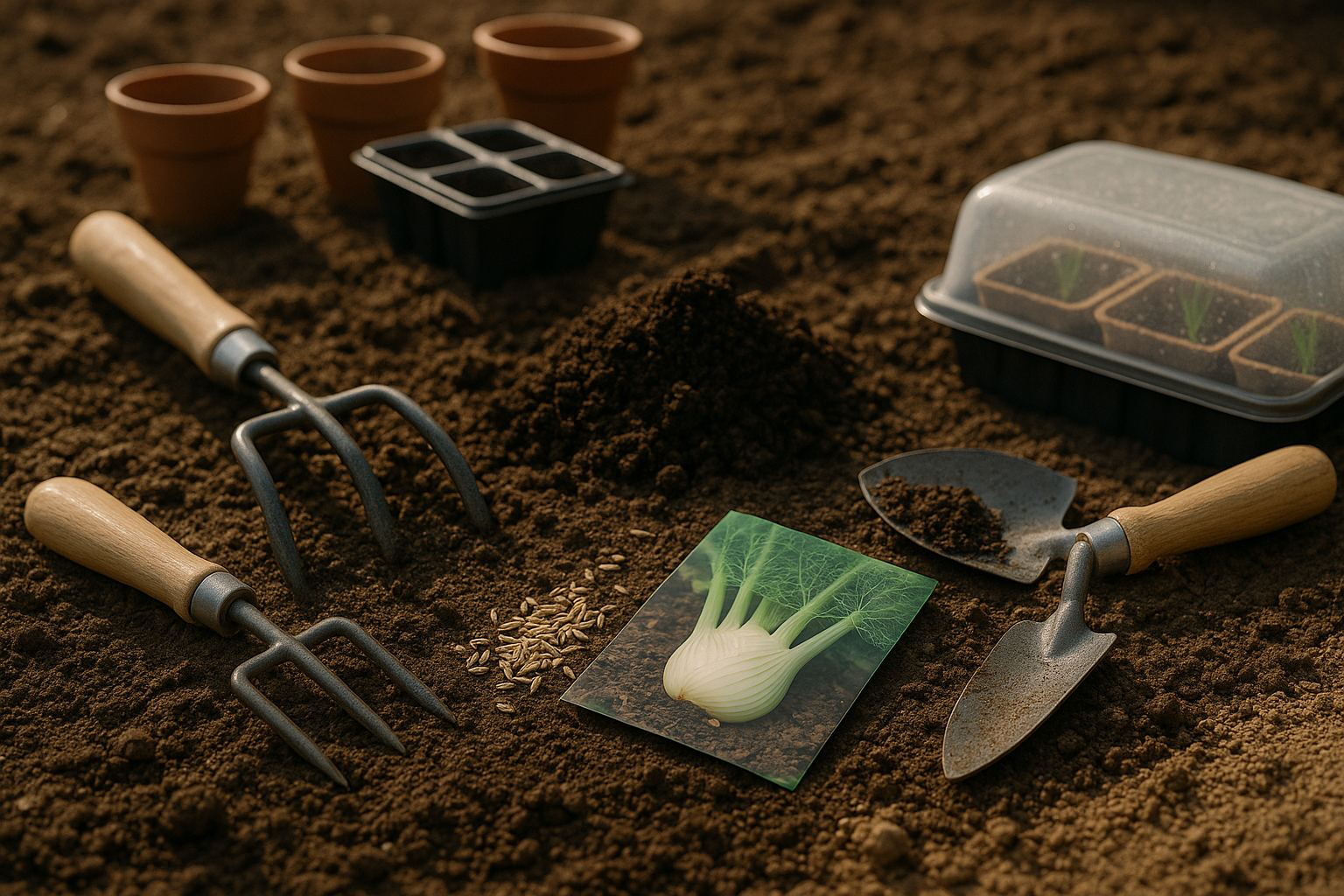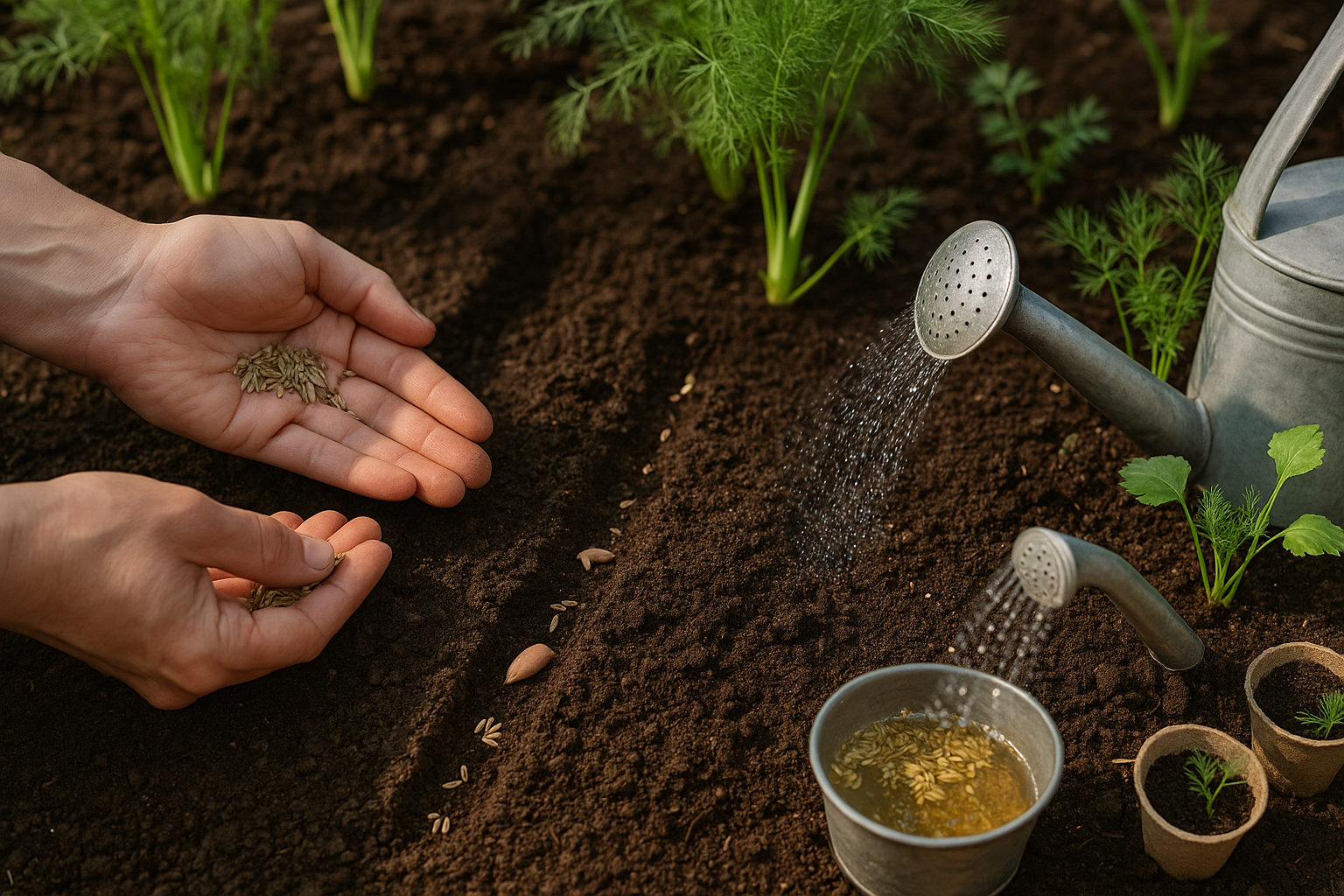Introduction
Wondering if you can grow fennel from seed in your own garden? Fennel, with its crisp anise flavor and aromatic fronds, is a standout herb used in everything from Mediterranean salads to rich soups and roasts. Its unique taste elevates home cooking, while the plant itself makes a striking addition to garden beds with its feathery green foliage and delicate yellow blooms.
The good news is that growing fennel from seed is not only possible—it’s surprisingly straightforward and rewarding for gardeners of all levels, whether you’re working with a spacious backyard plot or a few containers on a sunny patio. Starting fennel from seed allows you to choose the perfect variety for your needs, enjoy fresher harvests, and avoid the limitations of store-bought plants.
In this article, you’ll get a complete, step-by-step guide to the process—from selecting the best seeds and preparing your soil, to sowing, caring for young plants, and finally harvesting bulbs or seeds for your kitchen. Whether you’re new to gardening or an experienced grower, you’ll find tips, troubleshooting advice, and real-world examples to help you succeed in cultivating this flavorful and versatile herb right from seed to table.
Understanding Fennel & Its Varieties
Fennel is a versatile and aromatic plant that comes in two main varieties: Florence fennel, also known as bulb fennel, and herb fennel, sometimes called leaf fennel. Florence fennel is especially prized for its crisp, white bulb that grows at the base of the plant. This bulb has a mild, sweet, and subtly licorice-like flavor, making it a popular addition to salads, slaws, and roasted vegetable dishes. The stalks and feathery fronds are also edible and add brightness as a garnish.
In contrast, herb fennel is cultivated mainly for its feathery, deep-green leaves and aromatic seeds. Unlike Florence fennel, herb fennel doesn’t form a thick bulb; instead, its delicate fronds are snipped to flavor fish, soups, and even teas, while its seeds are harvested for use in spice blends and baking.
Both types of fennel thrive in sunny, well-drained garden soil and attract pollinators, which can benefit the entire vegetable patch. Florence fennel needs more space and consistent moisture to form a large, tender bulb, while herb fennel grows tall and airy, sometimes reaching five feet or more. It is often left to flower for ornamental flair or seed harvest.
Fennel stands out for its ability to provide multiple edible parts—bulb, stalks, leaves, and seeds—from a single plant, making it both practical and beautiful for home gardeners and cooks alike. Whether roasted, raw, or used as a flavoring, fennel’s unique taste and flexibility earn it a special place in the kitchen and garden.
Preparing for Sowing – Seed Selection & Site Prep

Choosing the right fennel variety is the first step toward a healthy, flavorful crop. Florence fennel is ideal if you want crisp bulbs for cooking, while common or bronze fennel is perfect for feathery foliage and seeds. Always source seeds from reputable suppliers, and check for freshness by looking at the packing or expiration date—older seeds may have lower germination rates.
Once you have your seeds, focus on the growing site. Fennel thrives in full sun, needing at least six hours daily, and prefers well-drained, fertile soil with a neutral to slightly acidic pH between 6.0 and 7.0. To prepare your soil, loosen it to a depth of at least 12 inches and incorporate plenty of organic matter, like compost or well-rotted manure. This will boost nutrient levels and improve water retention without making the soil soggy.
Good drainage is crucial; if your plot holds water after rain, consider using raised beds or mixing in coarse sand or horticultural grit. Remove all weeds before sowing, as fennel hates competition in its early stages. Laying down a layer of mulch after planting can also help keep new weeds at bay.
If you have a short growing season, start seeds indoors about 4–6 weeks before your last expected frost. Use seed trays with a light potting mix, keep them in a warm, bright spot, and transplant gently to avoid disturbing young roots. In milder climates, or once the weather consistently stays above 50°F (10°C), you can direct sow seeds where they will grow, spacing them about 12 inches apart to allow for bulb development.
With a little planning and attention to detail, you’ll start your fennel patch off strong.
Sowing Fennel Seeds – Step-by-Step Guide

Sowing fennel seeds is a straightforward process, whether you’re starting them indoors or planting directly outdoors. For direct sowing, wait until after the last frost and choose a location with full sun and well-draining soil. Loosen the soil to a fine tilth, then sow fennel seeds about ¼ inch deep—just enough to cover them lightly with soil.
Space seeds about 12 to 18 inches apart if you have the room, or scatter them thinly in rows about 18 inches apart, knowing you’ll need to thin them later. Once sown, gently water the soil so it’s evenly moist but not soggy, using a fine spray to avoid washing seeds out of place. For even germination, keep the soil consistently moist (but not waterlogged) during the 7-14 days it takes seeds to sprout.
If starting indoors, fill small pots or seed trays with quality seed-starting mix and sow seeds ¼ inch deep. Keep containers in a warm, sunny spot or under grow lights and maintain steady moisture. When seedlings have a few sets of true leaves and all risk of frost has passed, harden them off outside for a few days before transplanting. Space them 12 to 18 inches apart to give bulbs room to develop.
Whether sowing inside or out, once your fennel seedlings are a few inches tall, thin them to keep the strongest plants, as overcrowding can lead to spindly growth and poor bulbs. Mulching around recently thinned seedlings helps retain moisture and suppress weeds. Regular, gentle watering is key; try not to let the soil fully dry out.
For a continuous harvest, consider sowing seeds every 3-4 weeks throughout spring and early summer. By following these steps, you’ll give your fennel the best chance to establish, thrive, and reward you with a bounty of fragrant, flavorful bulbs and leaves.
Caring for Growing Fennel Plants
Caring for growing fennel plants isn’t difficult, but a few key steps can make a huge difference in their health and harvest. Start by watering consistently—fennel prefers soil that stays moist but never soggy. Aim for about one inch of water per week, adjusting if it’s especially hot or dry.
A layer of mulch, such as straw or compost, will help the soil retain moisture, keep roots cool, and suppress weeds that compete for resources.
For the richest bulbs and most robust foliage, use a balanced fertilizer or top-dress with compost once a month, especially if your soil isn’t naturally rich. When the bulbs start to swell at the base, gently mound soil around them, covering the lower part of the bulb to encourage it to stay white and tender while preventing sun damage.
Weeds can stunt growth and make harvesting difficult, so remove them by hand regularly, being careful not to disturb the shallow fennel roots.
To prevent fennel from bolting—flowering and going to seed prematurely—keep it consistently moist and cool during hot spells. Providing a bit of afternoon shade or row cover in extreme heat can help too.
Remember, overcrowding stresses plants and encourages bolting, so thin young fennel to allow at least 12 inches between each plant. Strong, healthy plants grow best with good airflow around them, so manage spacing and keep beds tidy.
With these simple habits—steady watering, proper feeding, regular weeding, and mulching—you’ll encourage your fennel to thrive, yielding sweet, crisp bulbs and lush fronds throughout the season.
Troubleshooting Common Fennel Growing Problems
Growing fennel can be rewarding, but gardeners often face setbacks like pests, diseases, premature bolting, and disappointing bulb growth. Aphids and caterpillars, for example, are notorious for munching on fennel leaves and stems. Instead of reaching for harsh pesticides, try spraying your plants with soapy water or introducing ladybugs to your garden as natural predators.
Fungal diseases, such as powdery mildew, can develop if air circulation is poor or the soil stays too wet. To prevent this, space your plants adequately and water at the base in the morning to keep leaves dry.
Preventing Bolting
Bolting—when fennel quickly sends up a flower stalk before forming a good bulb—usually happens in hot weather or if the plants are stressed. To avoid this, plant fennel early in the season so it matures before peak summer heat and keep the soil consistently moist but not waterlogged.
Encouraging Healthy Bulb Formation
Poor bulb formation often results from overcrowding or nutrient deficiencies. Make sure to thin seedlings so each plant has plenty of space (about one foot apart) and top-dress with compost to boost soil fertility.
Additional Tips
- Practice crop rotation—avoid planting fennel in the same spot where carrots or dill grew last year, since they share similar pests and diseases.
- Regular weeding and mulching help preserve soil moisture and suppress competing plants.
By combining these practical, organic strategies, you can overcome common fennel-growing hurdles and ensure your harvest is healthy and flavorful.
Harvesting & Using Homegrown Fennel
Knowing when to harvest fennel makes all the difference in flavor and tenderness. For bulbs, wait until they swell to the size of a tennis ball but haven’t split—usually about 90 days after sowing. Use a sharp knife to slice the bulb from the base just above the soil line, being careful not to damage neighboring plants.
If you’re harvesting fennel leaves, snip off the feathery fronds as soon as the plant is about 12 inches tall; take only a few fronds at a time to keep the plant healthy and productive. Always cut in the morning after the dew has dried, when essential oils and flavors are most concentrated.
Fennel bulbs are crisp and mildly sweet, perfect sliced raw in salads, roasted with root vegetables, or simmered in a Mediterranean stew. The aromatic fronds make a lovely garnish for fish dishes, potato salads, or can even be blended into pesto.
To store, wrap fennel bulbs in a damp paper towel and place them in a perforated plastic bag in your refrigerator’s crisper drawer; they’ll stay fresh for up to a week. Fronds can be placed in a glass of water like fresh herbs or chopped and frozen for longer storage.
By harvesting carefully and storing properly, you’ll enjoy the bright, anise-like flavor of homegrown fennel in a variety of dishes all season long.
Conclusion & Quick FAQ
Growing fennel from seed is surprisingly easy and rewarding, making it a fantastic choice for both new and experienced gardeners. This aromatic herb quickly transforms any garden or balcony with its feathery foliage and unique, anise-like flavor.
Even if you’re short on space, fennel can thrive in large pots—just ensure the container is at least 12 inches deep to accommodate its long taproot.
Wondering about germination? Fennel seeds typically sprout in 7 to 14 days in warm, well-drained soil.
Another common concern is whether fennel grows well alongside other veggies; it’s best to give fennel its own spot since it can inhibit the growth of some plants.
Overall, with a little sun, regular watering, and some patience, you’ll be enjoying homegrown fennel in no time. Don’t hesitate to give it a try—you might be surprised at how simple and satisfying it is!
